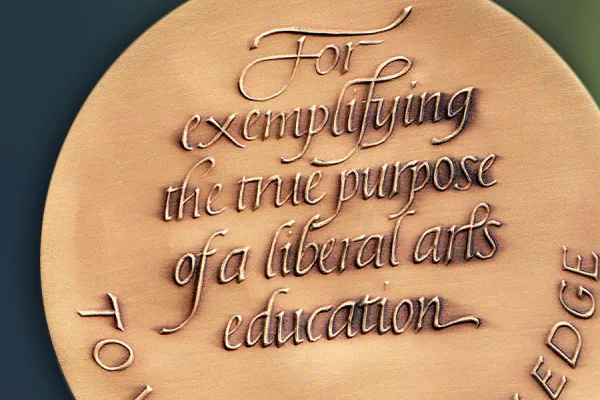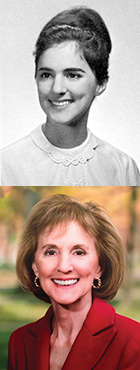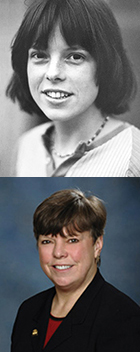Then and Now: A Really Day Preview with the 2015 Smith Medalists
News of Note

Published February 11, 2015
“Then and now” can be a valuable yardstick for measuring Smith pride—especially when it comes to the four extraordinary alumnae who will be honored next week as Smith medalists.
NOTE: Rally Day will be livestreamed beginning at 1:30 p.m. Eastern Time.
This year’s medalists are diplomat Gillian Martin Sorensen ’63, author Jane Abramson O’Connor ’69, physician Cynthia F. Bearer ’72 and financial literacy advocate Stephanie D. Neely ’85.
Each of these remarkable women has an important story to tell about how their days at Smith “back then” shaped the lives they are living now. They also have insights into important changes that have occurred in recent years in their chosen fields of international diplomacy, literature, child health and corporate finance.
The college will celebrate this year’s medalists on Rally Day, Wednesday, Feb. 18, at 1:30 p.m. in John M. Greene Hall. The convocation will be followed by a reception on the main level of the Campus Center.
The 2015 medalists will join more than 200 outstanding alumnae who have received the award for contributions to their communities and the world. The Smith College Medal was established in 1962 to recognize alumnae who exemplify in their lives and work Smith’s most deeply held values.
Faculty, students and staff also will have an opportunity to hear from the honorees about their experiences and expertise at a series of public presentations on Tuesday, Feb. 17. The complete schedule of medalist presentations is online.
Following is a preview based on some “then and now” reflections by the medalists. Photos courtesy of the Smith College Archives.

Gillian Martin Sorensen, diplomat
Then: Class of 1963, French major
Now: Senior adviser for the United Nations Foundation, member of the Council on Foreign Relations and Women’s Foreign Policy Group, former commissioner and assistant secretary general for external affairs at the United Nations
“I remember my days at Smith vividly. I’ve gained confidence since then, but at the core I’m the same person. The key interests I had then haven’t changed—my love of dance, of literature, eloquent public speaking, travel and foreign affairs. In retrospect, I can see a continuing thread, and it all makes sense. I was a public school girl from Michigan, and my first year at Smith, I was knocked back a bit by how smart everybody was and how much they had studied. What I did learn was how to learn, and I perfected my French—I spent my junior year in Paris. Since I entered the field of diplomacy, the depths of the crises have grown as have the number of brutal conflicts and refugees around the world. There is a huge need for diplomacy of all kinds, whether through government channels or non-governmental organizations. Technology has also had an enormous impact because information travels so fast. The kind of inside planning I saw at the United Nations—that planning still needs to be careful and farsighted, even with the flood of information. It raises the pressure.”

Jane Abramson O’Connor, author
Then: Class of 1969, English language and literature major
Now: Vice president and editor-at-large at Penguin Random House, creator of popular Fancy Nancy children’s book series
“When I was an English major, I typed papers on a typewriter, before there was even such a thing as little white-inked slips of paper (called Correct-type) to get rid of mistakes, and the only way to do research was to check a book out of the library. In my profession—book publishing—when I started out in the early 1970s, the only way to read was to open an actual printed book—even audio books were a thing of the future. The idea of reading on something called an ‘electronic device’ would have been unimaginable to me. At Smith, I was introduced to whole new worlds in literature—the England of Chaucer, Eliot and Dickens; Dostoyevsky and Tolstoy’s Russia; plays by Racine and Molière. Quite simply, it widened my understanding of what it meant to be a human being and deepened my belief that books are chief among things that change us for the better. Going into publishing was a no-brainer.”

Cynthia F. Bearer, physician
Then: Class of 1972, mathematics major
Now: Mary Gray Cobey Professor of Neonatology and chief of the Division of Neonatology in the Department of Pediatrics at the University of Maryland School of Medicine
“My confidence in myself is what has changed the most. I can take on challenges. That started for me at Smith—I began speaking up in my classes. Now, I have no trouble speaking up. That skill makes a real difference in research, where one has to propose things in a way that is forward thinking. One also has to be very good at explaining why something would be important to explore. Since I started in my profession, I’ve seen a whole new field of pediatric environmental health emerge. Lead poisoning was the beginning of that, where we began to look at how a child’s environment was affecting their long-term health. I wouldn’t have been able to be part of that new field if I hadn’t developed confidence in myself. I had amazing teachers at Smith. David Cohen was my math professor, and I became a math major because of his influence. He’d give us a theorem and say, ‘Your homework is to go off and prove this.’ You really had to reason things out for yourself. That’s an approach that’s shaped my thinking.”

Stephanie D. Neely, financial literacy advocate
Then: Class of 1985, economics major
Now: Vice president, treasury, and an officer of Allstate Insurance Company; treasurer of the City of Chicago from to 2006 to 2014
“Being a parent is what’s changed my perspective the most. My 16-year-old son, Justin, is my greatest joy and blessing. In terms of my career, I’ve been lucky to have experienced some amazing changes. (There was that infamous call from Chicago Mayor Richard Daley, asking me to be treasurer. I was elected twice—I need to write a book about that!). I started out at Smith thinking I would become a doctor. I was the first in my family to go to college, and I thought I’d be the first doctor in the family. But I took a macroeconomics class with Randy Bartlett and fell in love with the subject. After graduating, I went to business school and worked in finance. I remember interviewing at Smith Barney and being told if hired, I’d be the first black woman there. Even back in 1985 that was hard to believe! Fast forward 30 years and things have changed—there are more women in finance, though still not so many minorities. Change has to come from the ground up. People who are in the room need to speak up and say, ‘Where’s your diversity?’ Because I am in the room, I want to be asking the difficult questions.”